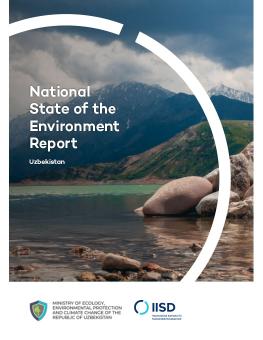
National State of the Environment Report: Uzbekistan
A healthy environment and its sustainable management are critical for citizens' well-being and supporting Uzbekistan's growing economy. The National State of the Environment Report (NSoER) is a comprehensive document that provides a snapshot of current environmental trends in Uzbekistan's socio-economic development for citizens, experts, and policy-makers. This report was prepared with the support of the United Nations Economic Commission for Europe, the United Nations Environment Programme (UNEP), and the Food and Agriculture Organization of the United Nations, along with financial support from the Global Public Goods and Challenges Programme Cooperation Agreement between the European Commission and UNEP.
-
A decade of environmental change is captured in the recent National State of the Environment Report of Uzbekistan.
-
The National State of the Environment Report is a comprehensive document that provides a snapshot of current environmental trends in Uzbekistan's socio-economic development for citizens, experts, and policy-makers.
-
Decade of trends for critical environmental issues, including air, water, and biodiversity, are reviewed in the recent National State of the Environment Report.
The analyzed environmental trends need to inform decision making and improve citizen engagement in natural resource management and environmental protection. This report thus aims to connect actions creating drivers and pressures influencing the state of the environment and relevant responses to address environmental challenges.
Our approach uses the Drivers– Pressures–State–Impacts–Responses (DPSIR) framework to draw connections between the state of the environment and the drivers and pressures on the environment. The framework brings together five critical elements of development in a connected framework to integrate the causes of environmental degradation (as well as environmental improvements) into a chain of causes and consequences. The DPSIR framework provides a suitable model for describing the interaction between human activities and the environment.
Based on the application of the DPSIR framework, the NSoER team, with the participation of stakeholders, identified the specific drivers, pressures, and components of the environment, such as atmospheric air, water resources, land, and specific ecosystems.
Participating experts
You might also be interested in
Ottawa supports Big Oil over the climate
One can only imagine the positive buzz these days inside the boardrooms of Canada's oil companies, as they rake in record profits and plan major expansions of their oil production. Amid all the good cheer, one could easily lose sight of the fact that those plans will push the world dangerously closer to the brink of irreversible climate chaos. Even as the world finally signed a commitment at UN climate talks last month to begin transitioning away from fossil fuels, Canada's major oil companies are poised to do exactly the opposite — to greatly expand their fossil fuel production.
What Is the UAE Framework for Global Climate Resilience, and How Can Countries Move It Forward?
With the introduction of the new framework for the Global Goal on Adaptation (GGA), COP 28 marked a milestone for adaptation. We unpack key outputs and set out how countries can move forward by strengthening their national monitoring, evaluation, and learning (MEL) systems.
Essential Monitor's Guide for Prairie Water Retention
This guidance document aims to make water retention monitoring a more accessible practice from a technical standpoint by demystifying some of the considerations required to get started.
IGF Case Study: Leveraging Technologies for Gender Equality in Mining Communities
How can sharing technological infrastructure support gender equality and serve the broad betterment of mining communities?